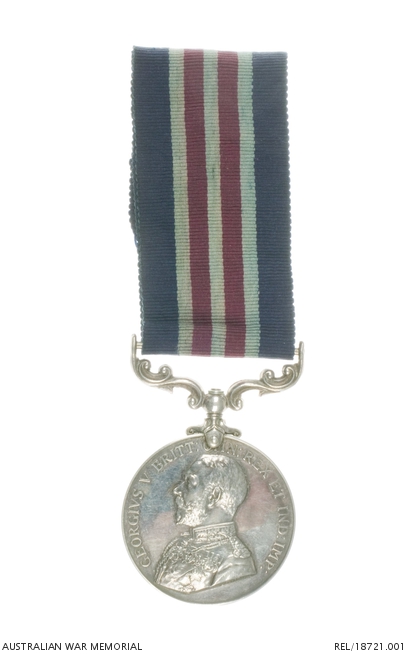| Places | |
|---|---|
| Accession Number | REL/18721.001 |
| Collection type | Heraldry |
| Object type | Award |
| Physical description | Silver |
| Maker |
Unknown |
| Place made | United Kingdom |
| Date made | c 1917 |
| Conflict |
First World War, 1914-1918 |
Military Medal : Sergeant E G Cowcher, 17 Battalion , AIF

Military Medal (Geo V). Impressed around edge with recipient's details.
Edward ' Teddy' George Cowcher was born in Sydney, NSW, in 1894 and was working as a machinist at Pyrmont when he enlisted in the AIF, at the age of 21, on 1 March 1915. After initial training in Australia he was assigned as a private to D Company, 17 Battalion, with the service number 1173.
The battalion sailed for Egypt on 12 May aboard the transport HMAT A32 Themistocles. After further training in Egypt the battalion landed at Anzac Cove at Gallipoli on 20 August, in time to take part in the attack on Hill 60. It was subsequently tasked with the defence of Quinn's Post until the allied troops were withdrawn from the Anzac and Suvla areas to Egypt in December.
In March 1916, Cowcher moved with his battalion to France for service on the Western Front. The battalion's first major engagement was at Pozieres in July 1916. At the end of the year Cowcher was promoted to lance corporal, then to corporal in March 1917 and to sergeant the following month.
During the fighting near Noreuil Cowcher was twice recommended for the award of a Military Medal, although only one award was made. The original, unsuccessful, recommendation reads: '1/3/1917. For conspicuous gallantry and devotion to duty. He directed and controlled the fire of two Lewis Guns which were in the open and exposed to enemy M.G. and shell fire, and inflicted many casualties. 2/3/1917. After bombing party had been driven down LAYTON LANE, Cpl Cowcher held a barricade with his Lewis Gun while bombs were being freely exchanged'. The subsequent, successful, recommendation, made on 13 May 1917, reads: 'During operations on 3/4th. May against the HINDENBURG line near NOREUIL, the N.C.O. was in charge of his Company Lewis Guns and when one of his crews were wiped out he saved the gun and with it assisted Sgt. McKAY'S party to bomb up the trench. When his ammunition gave out he got a captured German M.G. into action and kept it going until the party now reduced in numbers, was forced to give ground owing to the enemy counter-attacking on two sides. This N.C.O. has been previously recommended for good work'.
Cowcher went on to fight in the Second Battle of Bullecourt and at Menin Road in Belgium before being posted to the School of Musketry at Tidworth, England on 27 September. Here he qualified as a 2nd class Lewis Gunner before rejoining his battalion in Belgium at the end of November as sergeant in charge of one of the battalion's machine gun sections. In 1918 the battalion returned to France, helping to repel the German's Spring Offensive, then fighting at Amiens and, in August, at Mont St Quentin.
Early on the morning of 3 October 1918 the battalion was located near Jeancourt, north of St Quentin, preparing to take part in the attack on the Beaurevoir Line at Montbrehain, in what would prove to be its final day in action during the war. At about 7 am Teddy Cowcher died instantly when he was hit by German machine gun fire. He was buried near Jeancourt, until 1920, when his body was exhumed and reinterred in the Bellicourt British Cemetery.